-
Paper Information
- Paper Submission
-
Journal Information
- About This Journal
- Editorial Board
- Current Issue
- Archive
- Author Guidelines
- Contact Us
American Journal of Computational and Applied Mathematics
p-ISSN: 2165-8935 e-ISSN: 2165-8943
2023; 13(1): 6-14
doi:10.5923/j.ajcam.20231301.02
Received: Jan. 29, 2023; Accepted: Feb. 13, 2023; Published: Jun. 26, 2023

Numerical Investigation of HIV/AIDS Dynamics Among the Truckers and the Local Community at Malaba and Busia Border Stops
Ancent Makau Kimulu
Department of Mathematics and Actuarial Science, Kenyatta University, Nairobi, Kenya
Correspondence to: Ancent Makau Kimulu, Department of Mathematics and Actuarial Science, Kenyatta University, Nairobi, Kenya.
| Email: |  |
Copyright © 2023 The Author(s). Published by Scientific & Academic Publishing.
This work is licensed under the Creative Commons Attribution International License (CC BY).
http://creativecommons.org/licenses/by/4.0/

Busia and Malaba are the busiest border crossing points for truckers using the Northern Corridor connecting landlocked countries of Uganda, DR Congo, South Sudan and parts of Rwanda to Mombasa port. On average, Malaba and Busia clears 1000 and 600 trucks respectively per day. Delays in clearance of the trucks causes long queues at crossing points and influx of truckers in these respective towns. The truckers spent this time in the company of commercial sex workers and interact with the local communities in these towns, hence this is a conduit of spread of HIV/AIDS in these regions. This paper designed a model to study the HIV/AIDS dynamics in this border towns. The reproduction number, the disease-free equilibrium and endemic equilibrium points determined using the Next Generation Matrix (NGM) method. From the analysis of the model, it is found that delays in clearance time increases the force of infections from females to males. It is found out that also found out that increase in force if infections to males from females increases the male HIV infections. This is due to prolonged time of sexual interactions as the trucks await clearance and also due to higher number of male truckers than females. Furthermore, the analysis shows that delays in clearance time leads to increase in both male and female HIV/AIDS infections which causes an increase in the number of AIDS cases in this border crossing points.
Keywords: Truckers, HIV, AIDS, Next Generation Matrix
Cite this paper: Ancent Makau Kimulu, Numerical Investigation of HIV/AIDS Dynamics Among the Truckers and the Local Community at Malaba and Busia Border Stops, American Journal of Computational and Applied Mathematics , Vol. 13 No. 1, 2023, pp. 6-14. doi: 10.5923/j.ajcam.20231301.02.
Article Outline
1. Introduction
- Kenya has many border stations, however Busia and Malaba are most commonly used by heavy commercial vehicles. The Malaba border is the busiest crossing point for truckers using the Northern Corridor and connects landlocked countries of Uganda, DR Congo, South Sudan and parts of Rwanda to Mombasa port. Approximately 1,000 cargo trucks pass through the Malaba one stop border post daily while Busia handles an average of 600 trucks according to Bulzomi et al. [1]. According to the first volume of the final report of the Africa Trade Mark East Africa in 2014, the high volumes of traffic on the Northern Corridor have stretched these stations; causing long queues of trucks and delays in clearance of freight [2]. These delays make the truckers wait for long time for clearance while interacting with the local communities at these border towns. Malaba border post clears over 1,000 trucks daily which is a tall order compared to the high number of trucks using the route since 80% of cargo to Uganda, South Sudan, DR Congo, Rwanda and Burundi passes here [3]. Clearance backlog at the Malaba border is threatening to increase costs and expose importers to higher storage charges. These delays are caused by frequent downtimes on Kenya Revenue Authority's (KRA) scanner at the border [4]. According to Maredi [5], truckers spend a few hours to several days at the border while the trucks are loaded with new goods or while customs processes are being cleared. Truckers spent this time in the company of commercial sex workers since they spent approximately less than 40 days a year at home with their families. East African countries have the highest HIV prevalence and high number of people living with HIV and AIDS [6]. Also the mobile populations which includes the truckers were key in the spread of COVID-19 and HIV pandemics. According to the NACC in charge of HIV policy in Kenya, border towns and counties in Kenya had the highest rates of new HIV infections [7].Truckers are in the category of vulnerable populations to HIV and AIDS and hence can be a conduit of spread of the disease [8-10]. Results found that the HIV prevalence among the truckers in Kenya was 26-27%. Hence unprotected sexual interaction between the truckers and local community at Malaba and Busia would lead to spread of the pandemic within the locality. Also according to study by Nzyuko et al. [11] carried out at Malaba and Sachangwan indicated that 46% of girls reported usually having sex with truck drivers, 78% of girls reported usually exchanging sex for gifts or money and 59% of boys reported usually giving gifts or money for sex. This can lead to the spread of HIV from truck drivers and sex workers to adolescents in this stop overs along the Trans African highway in Kenya. According to [12], the tuckers along the Trans African highway are vulnerable to HIV and AIDS as a result of more time they spent away from their families. Other challenges on the highway includes poor road conditions, delays at the border crossing points which increases the time of travel between the designated destinations and lack of security in some sections of the highway especially as they drive at night. In Kenya, small towns offering truckers stops and rest bays like Mariakani, Voi, Mlolongo, Naivasha, Malaba and Busia, expose the truckers to environmental hazards such as HIV/ AIDS, drug and alcohol abuse. This could also lead to a similar exposure of the risk of HIV/ AIDS infection to the locals. According to Mulholland et al. [13], sexual networks include partnerships across resident, migrant, and mobile populations in the cross-border areas like Malaba and Busia. This implies that there is a lot of sexual activities at cross-border towns between truckers and the local community. Morris & Ferguson [14] found that there was an estimated population of 8000 female sex workers along the Northern corridor highway in Kenya. Furthermore, the female sex workers had 129 different sex partners and 634 sexual acts per year. The results also indicated that there were approximately 3200 – 4148 new HIV infections per year.The above literature indicates that the truckers and their cohort can serve as conduits for the spread of HIV and AIDS along the corridor and to the local communities in the various stop-overs along the highway. This study uses the knowledge of mathematical modeling to study the effects of clearance time on HIV and AIDS dynamics of spread between the truckers and the local communities at Malaba and Busia border stops. The force of infection is considered as a decaying exponential function while the population is largely classified into the binary compartment of male and female.
2. Methodology
- The model flowchart is shown in figure 1. To formulate the model, only the adult populations are considered and some reasonable assumptions are placed. These assumptions include the following;i. Truckers involves both male and female drivers and their assistants.ii. Heterosexual intercourse is the main means of HIV transmission between truckers and local community.iii. There was heterogeneous mixing between the truckers and the local communities at Malaba and Busia.
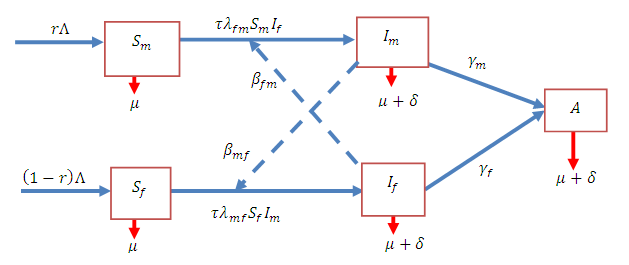 | Figure 1. Model flowchart |
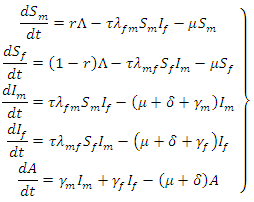 | (1) |
 and all parameters are between 0 and 1, i.e.,
and all parameters are between 0 and 1, i.e., 

3. Qualitative Analysis of the Model
- Theorem 1: (Positivity and boundedness)For time
 the solutions of system
the solutions of system  are confined in the set
are confined in the set  Proof:Let
Proof:Let  be any solution set with positive initial conditions. The total population satisfies the equation
be any solution set with positive initial conditions. The total population satisfies the equation  whose time derivative is given by,
whose time derivative is given by, 
 Using theory of differential equations (see [12]), then
Using theory of differential equations (see [12]), then Hence, our solution to system (1) is biologically feasible in the region
Hence, our solution to system (1) is biologically feasible in the region  and is bounded and positively invariant.
and is bounded and positively invariant. 
3.1. Equilibrium Points
- The disease-free equilibrium point (DFE) is the point at which there is no HIV at Malaba and Busia border stop and its environs. It is obtained by setting
 in system (1) and we obtain the DFE
in system (1) and we obtain the DFE  as;
as; The Endemic Equilibrium Point (EEP) is the point at which the HIV persists at Malaba border stop and it is spreading in the population. According to Kaur et al. [15], the EEP is obtained by solving the system (2) below
The Endemic Equilibrium Point (EEP) is the point at which the HIV persists at Malaba border stop and it is spreading in the population. According to Kaur et al. [15], the EEP is obtained by solving the system (2) below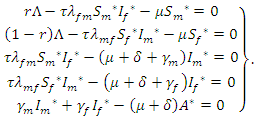 | (2) |
 where
where

3.2. Reproduction Number
- Kaur et al. [15] and Kimulu et al. [16] defined the reproduction number
 as the average number of new HIV infections caused by a single infectious individual in a susceptible population in an entire infectious period. It is determined by the next generation matrix (NMG) method where
as the average number of new HIV infections caused by a single infectious individual in a susceptible population in an entire infectious period. It is determined by the next generation matrix (NMG) method where  and
and  represents matrices of new infections and transitions out of the infected classes respectively, given by;
represents matrices of new infections and transitions out of the infected classes respectively, given by; The Jacobian matrices of
The Jacobian matrices of  and
and  at the DFE are denoted as
at the DFE are denoted as  and
and  respectively and thus, we have;
respectively and thus, we have; | (3) |
 | (4) |
 | (5) |
 The
The  is obtained as the spectral radius of the next generation matrix
is obtained as the spectral radius of the next generation matrix  as
as 
3.3. Stability Analysis [17-20]
- Theorem 2: (Local stability of Disease-Free Equilibrium). The DFE
 is locally asymptotically stable when
is locally asymptotically stable when  and is asymptotically unstable when
and is asymptotically unstable when  Proof:The local stability of DFE was studied by determining the Jacobian matrix of system (1) at DFE. The eigenvalues were calculated and their nature was used to determine the stability of the DFE. The Jacobian matrix for system (1) at DFE is given by;
Proof:The local stability of DFE was studied by determining the Jacobian matrix of system (1) at DFE. The eigenvalues were calculated and their nature was used to determine the stability of the DFE. The Jacobian matrix for system (1) at DFE is given by; | (6) |
 | (7) |
 and the remaining two eigenvalues are obtained by solving the quadratic equation;
and the remaining two eigenvalues are obtained by solving the quadratic equation; | (8) |

 (i) is always true since all parameters are positive and (ii) implies
(i) is always true since all parameters are positive and (ii) implies  Thus, the DFE is locally asymptotically stableif
Thus, the DFE is locally asymptotically stableif  To prove the global stability, the theorem by Castillo-Chavez et al. [21] is used.Theorem 3: [21] The system (1) can be written in the form:
To prove the global stability, the theorem by Castillo-Chavez et al. [21] is used.Theorem 3: [21] The system (1) can be written in the form: | (9) |
 is the number of uninfected individuals,
is the number of uninfected individuals,  gives the HIV infectives and the AIDS patients. The DFE is denoted by
gives the HIV infectives and the AIDS patients. The DFE is denoted by  The conditions
The conditions  and
and  stated below must be satisfied for global asymptotic stability to be guaranteed,
stated below must be satisfied for global asymptotic stability to be guaranteed, is globally asymptotically stable,
is globally asymptotically stable, and
and  is an M-Matrix and in the region where model makes biological sense.Theorem 4: (Global stability of the DFE). The DFE
is an M-Matrix and in the region where model makes biological sense.Theorem 4: (Global stability of the DFE). The DFE  is globally asymptotically stable if
is globally asymptotically stable if  and assumptions in equation (9) are sastisfied.Proof:Consider
and assumptions in equation (9) are sastisfied.Proof:Consider  and
and  | (10) |
 | (11) |
 hence
hence  .
.  is an M-matrix therefore DFE is globally asymptotically stable when
is an M-matrix therefore DFE is globally asymptotically stable when  .
.  Theorem 5: (Global stability of EEP). Let
Theorem 5: (Global stability of EEP). Let  be the endemic equilibrium of the system (1) and
be the endemic equilibrium of the system (1) and  be a positive definite function on some neighborhood of
be a positive definite function on some neighborhood of  then
then  is globally asymptotically stable if
is globally asymptotically stable if  Proof:Let the Lyapunov function be;
Proof:Let the Lyapunov function be; | (12) |
 is given by,
is given by, | (13) |
 and
and  we obtain;
we obtain; | (14) |
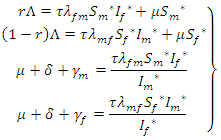 | (15) |
 | (16) |
 is globally asymptotically stable if
is globally asymptotically stable if  Using equation (16), then
Using equation (16), then 





4. Numerical Simulation and Analysis
- The system (1) which models the effect of clearance time on HIV and AIDS dynamics between truckers and the local community was simulated using MATLAB ODE45 solver [24-26]. The following default parameters were used for simulation.
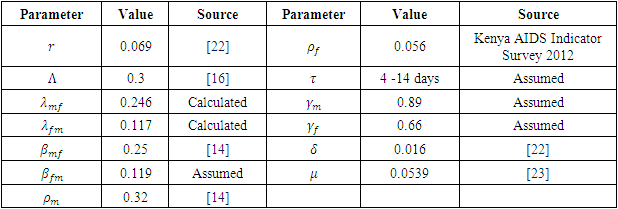
4.1. Analysis of Results
- From the analysis of the results, figures (2-4) shows the effects of force of infection of females to males
 with time on the HIV/AIDS dynamics between truckers and local community at Malaba and Busia border stops. Figure 2 shows that the susceptible male population increases with increase in
with time on the HIV/AIDS dynamics between truckers and local community at Malaba and Busia border stops. Figure 2 shows that the susceptible male population increases with increase in  This is attributed to the influx of truckers at the Malaba and Busia border stops due to delay in the clearance time. Also as
This is attributed to the influx of truckers at the Malaba and Busia border stops due to delay in the clearance time. Also as  increases the number of HIV infections among the males increases as indicated in figure 3 This is as a result of higher number of susceptible population as indicated in figure 2 increase in the force of infection from females to males which implies more infections in the males. In figure 4, increases in
increases the number of HIV infections among the males increases as indicated in figure 3 This is as a result of higher number of susceptible population as indicated in figure 2 increase in the force of infection from females to males which implies more infections in the males. In figure 4, increases in  produces an increase in the number of AIDS cases initially and reduces exponentially with time due to increase in HIV infections as indicated in figure 3.
produces an increase in the number of AIDS cases initially and reduces exponentially with time due to increase in HIV infections as indicated in figure 3. | Figure 2. Variation of  with with  |
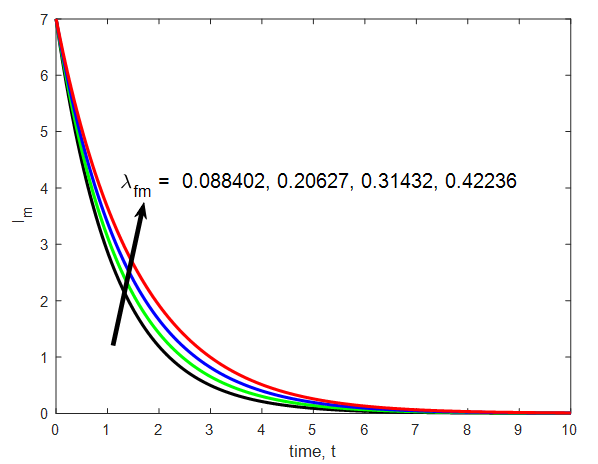 | Figure 3. Variation of  with with  |
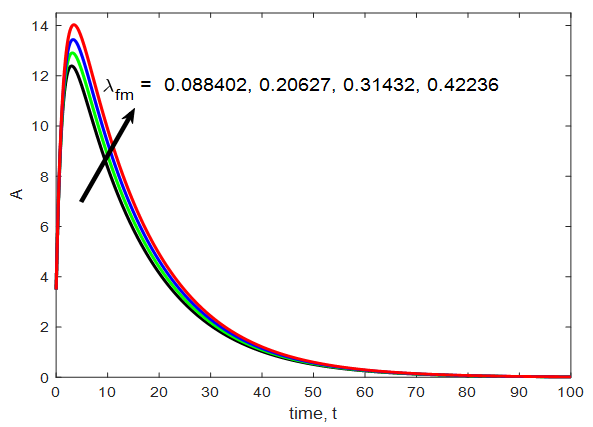 | Figure 4. Variation of  with with  |
 and
and 
 then decreases exponentially with time as shown in figure 9.
then decreases exponentially with time as shown in figure 9.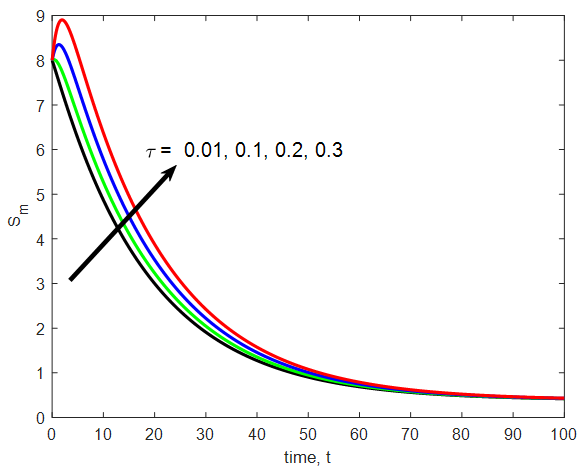 | Figure 5. Variation of  with with  |
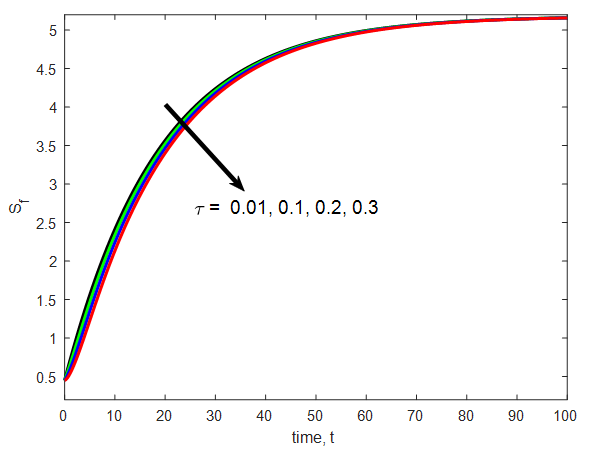 | Figure 6. Variation of  with with  |
 | Figure 7. Variation of  with with  |
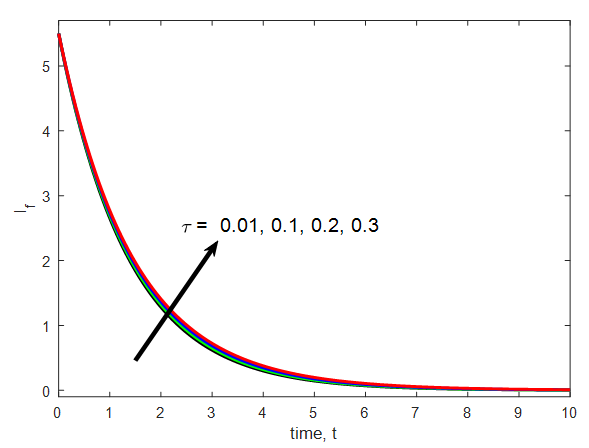 | Figure 8. Variation of  with with  |
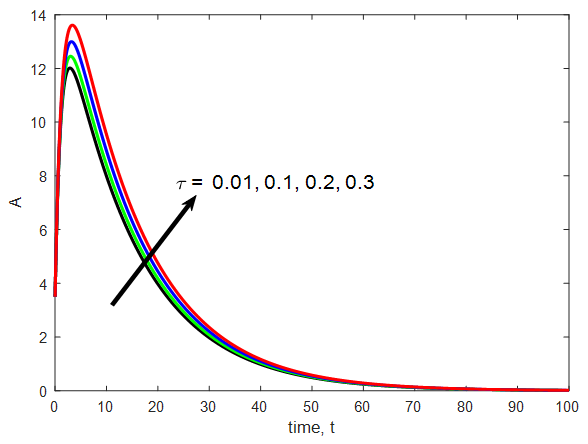 | Figure 9. Variation of  with with  |
5. Discussion of Results
- The numerical simulations in figures (2-4) shows the effects of force of infection from females to males on the HIV/AIDS dynamics at Malaba and Busia border towns. In figure 2, as
 increases, the susceptible male population increases. This is attributed to the increase in the susceptible population of males and females hence more sexual interactions at the border stop towns due to the delays in the clearance freight across the border. Increase in
increases, the susceptible male population increases. This is attributed to the increase in the susceptible population of males and females hence more sexual interactions at the border stop towns due to the delays in the clearance freight across the border. Increase in  increases the number of HIV infected males as displayed in figure 3. This is as a result of influx of truckers at the border stop towns as a result of delays in clearance across the border. These delays increases the number of interactions between truckers and the local communities increases the number males infected by the females. The increase in HIV male infections results to increase in the number of AIDS cases from figure 4. This is because more males will be progressing to AIDS class because AIDS is not curable.Figures 5-9 displays the effects of clearance time on HIV/AIDS dynamics at Malaba and Busia border towns. From figure 5, the susceptible males increases with increase in the length of the clearance time due to influx of truckers at the towns as a result of delays in clearance across the border. The susceptible females slightly decreases as
increases the number of HIV infected males as displayed in figure 3. This is as a result of influx of truckers at the border stop towns as a result of delays in clearance across the border. These delays increases the number of interactions between truckers and the local communities increases the number males infected by the females. The increase in HIV male infections results to increase in the number of AIDS cases from figure 4. This is because more males will be progressing to AIDS class because AIDS is not curable.Figures 5-9 displays the effects of clearance time on HIV/AIDS dynamics at Malaba and Busia border towns. From figure 5, the susceptible males increases with increase in the length of the clearance time due to influx of truckers at the towns as a result of delays in clearance across the border. The susceptible females slightly decreases as  increases as shown in figure 6 which can be attributed to the fact that more truckers are males leading to more female infections reducing the susceptible female population. Figures 7 and 8 shows that as
increases as shown in figure 6 which can be attributed to the fact that more truckers are males leading to more female infections reducing the susceptible female population. Figures 7 and 8 shows that as  increases HIV/AIDS infections for both male and female populations. This due longer period of sexual interactions between incoming truckers and the local communities producing more HIV/AIDS infections. The increase in HIV/AIDS infections due to delay in clearance time and hence more sexual interactions consequently leading to increase in AIDS cases at border crossing points.
increases HIV/AIDS infections for both male and female populations. This due longer period of sexual interactions between incoming truckers and the local communities producing more HIV/AIDS infections. The increase in HIV/AIDS infections due to delay in clearance time and hence more sexual interactions consequently leading to increase in AIDS cases at border crossing points. 6. Conclusions
- This paper formulated a mathematical model to study the effects of clearance time on HIV/AIDS dynamics between truckers and local community at Malaba and Busia border stops. The model was numerically solved and analyzed using MATLAB ode45 solver. The analysis indicates that delays in clearance of trucks at Malaba and Busia increases the susceptible population due the presence of incoming truckers. This further increases sexual interactions between the truckers and the local community which increases HIV/AIDS infections and hence more AIDS cases at the border crossing points. The Kenyan government through the Kenya Revenue Authority department should collaborate with the Uganda and other countries whose use these points to use most recent technology to clear the cargo at the border points. This may involve clearing the cargoes even before arriving to reduce long queues at the border points. They should also collaboratively set up backup systems to use during KRA downtimes.
Definition of Parameters

 Abstract
Abstract Reference
Reference Full-Text PDF
Full-Text PDF Full-text HTML
Full-text HTML